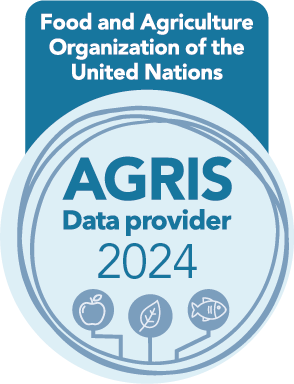Effect of application of Chlorpropham in sprouting of olluco tubers (Ullucus tuberosus L.) under storage
DOI:
https://doi.org/10.17268/sci.agropecu.2011.02.04Keywords:
Ullucus tuberosum L., Chlorpropham, sprouting, storage.Abstract
It was evaluated the effect of Chlorpropham on the sprouting of root’s tubers vegetables (Ullucus tuberosum L.) Tarmeño variety during storage at 15 °C and RH of 85 %, the treatments were 0, 5, 10, 20 and 30 mg of Chlorpropham / kg of tubers, in a completely random design with 4 repetitions. After 60 days of storage the sprouts, length for the control without Chlorpropham was 9.63 cm and for the treatments with Chlorpropham from 0.22 to 0.71 cm after 90 days the length of the sprouts were kept the same and some of them began to dry up, except the control where increased in size from 15 to 20 cm. After 90 days of storage, weight loss for the treatments with Chlorpropham was averaged of 21 % and for the witness of 37.35 %. All Chlorpropham treatments showed a lower number of sprouts per tuber, lower length of buds, fewer number of tubers with sprouts and less weight loss, with a p <0.05, Duncan test showed don’t exist significant differences between treatments with Chlorpropham for the assessed variables, but significant differences with the control treatment.
References
Anli, A.; Karado, A.; Tonguc, M. 2010. Baydar, h. effects of caraway (carum carvi l.) seed on sprouting of potato (Solanum tuberosum L.) tubers under different temperature conditions.Turkish Journal of Field Crops 15(1): 54-58.
Booth, R.; Shaw, R. 1985. Principios de almacenamiento de papa. Editorial Agropecuaria Hemisferio Sur SRL, Centro internacional de la Papa. Lima-Peru, Motevideo-Uruguay.
Bradshaw, N. 2006. Pesticide Residue Minimisation-Potatoes. Editors: Nick Bradshaw, Sue Ogilvy ADAS, Food Standards Agency-UK.
Caldiz, D.; Lanfrancon, L.; Fernández, L.; Nasetta, M. 1999. Aplicación de hidrazida maleica en papa (Solanum tuberosum L cv. Spunta) y sus efectos sobre el rendimiento, la brotación y el nivel de residuos en los tubérculos. Revista Latinoamericana de la papa 11(1): 164-172.
King, S.; Gershoff, S. 1987. Nutritional evaluation of three underexplolted Andean tubers: Oxalis tuberose (Oxalidaceae), Ullucus tuberosus (Basellaceae) and Tropaeolum tuberosum (Tropaeolaceae). Economía Botánica 41 (4): 503-511.
Lewis, M..; Thornton, M.; Kleinkopf, M. 2001. Comercial application of sprout inhibitor, CIPC, to storage potatoes. Potato storage research. Kimberly Research and Extension Center. Kimberly, Idaho.
López, G.; Hermann, M. 2004. El cultivo del ulluco en la sierra central del Perú. Serie: Conservación y uso de la biodiversidad de raíces y tubérculos andinos: Una década de investigación para el desarrollo (1993-2003). N° 3. Centro Internacional de la Papa, Universidad Nacional del centro, Instituto Vida en los Andes, Universidad Nacional Agraria La Molina, Agencia Suiza para el Desarrollo y la Cooperación. Lima, Perú. 133 pp.
Martínez, C. 1987. Aspectos Fisiológicos en el Cultivo de Papa. Programa de Papa. Universidad Agraria La Molina. Perú.
Plissey, E. 1996. Maintaining Tuber Health During Harvest, Storage, and Post-storage Handling. In: R. C. Rowe (ed.), Potato Health Managament. APS PRESS. The American Phytopathological Society. Chapter 6: pp 41-55.
Prange, R.; Kalt, W.;Daniels-Lake, B.; Walsh, J.; Dean, P.; Coffin, R.; Page, R. 1997. Alternatives to currently used potato sprout suppressants. Conference Proccedings. Postharvest News and Information Vol. 9 (3): 37N-41N.
Valladolid, R. 1995. Acción de inhibidores en brotes de olluco (Ullucus tuberosus Loz). Tesis. Universidad Agraria La Molina. Facultad de Agronomía. Perú. 48 pp.
* Autor para correspondencia.
E-mail: frankervba@hotmail.com (. Velásquez).
Recibido 04 abril 2011.
Aceptado 03 junio 2011.
Downloads
Published
How to Cite
Issue
Section
License
The authors who publish in this journal accept the following conditions:
a. The authors retain the copyright and assign to the magazine the right of the first publication, with the work registered with the Creative Commons attribution license, which allows third parties to use the published information whenever they mention the authorship of the work and the First publication in this journal.
b. Authors may make other independent and additional contractual arrangements for non-exclusive distribution of the version of the article published in this journal (eg, include it in an institutional repository or publish it in a book) as long as it clearly indicates that the work Was first published in this journal.
c. Authors are encouraged to publish their work on the Internet (for example, on institutional or personal pages) before and during the review and publication process, as it can lead to productive exchanges and a greater and faster dissemination of work Published (see The Effect of Open Access).




